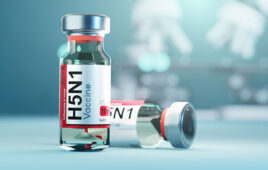
According to its mission statement, the National Brain Tumor Society (NBTS) is fiercely committed to finding better treatments, and ultimately a cure, for people living with a brain tumor today and anyone who will be diagnosed tomorrow.
This means effecting change in the system at all levels, including “funding innovative, difference-making research, shaping public policies, and providing empowering information to patients to be stronger as patients face this disease in an era of precision molecular medicine that is now so important to the patient journey,” said David Arons, CEO in an exclusive interview with Drug Discovery & Development (DDD).
“We’re aggressively going after the cure, particularly in a space that’s seen so little progress in terms of drug development over the last 50 years,” he adds. “We’ve seen some great biological progress in terms of tumors but we still have a long way to go.”
Earlier this year, the organization launched the NBTS Clinical Trial Finder on its website to help simplify the process of finding and participating in clinical trials. DDD spoke with Arons along with Michael Antonellis, national director of marketing communications for NBTS, about the reason for developing the search engine and how it hopes to facilitate better treatments.
DDD: Why the focus on recruiting trials?
David Arons: In this era of precision medicine we absolutely need a more educated, informed patient-caregiver community who is readier than ever to participate in clinical trials. Across oncology, only about 6 percent of eligible patients actually accrue into clinical trials. In brain tumors, in pediatrics it’s much higher, in glioblastoma as one brain tumor, it’s a high accrual rate, but overall it’s not where it needs to be. So we’re trying to drive patients, as well as medical oncologists, to be educated about medical trials to try to help those accrual rates increase.
In addition, it’s about making sure that it’s the right patient for the right trial; the right trial for the right patient.
DDD: How is that done exactly? Through biomarkers?
David Arons: Absolutely. We’ve seen over the last few years a lot more biomarker-driven trials. We’re seeing eligibility not just by the tumor histology but the molecular signatures within that tumor. It’s so important that patients understand the molecular signatures of their tumor. And it’s especially important because in 2016 the World Health Organization reclassified brain tumors, not just by histology, but by those molecular markers so we’re seeing more trials with eligibility criteria.
This means that patients need to understand their pathology reports. We’re working on the patient education front to make sure patients understand their pathology and they ask the right questions about clinical trials. We’re pushing the bureau of oncology and medical oncology field to educate and talk about clinical trials from the time of diagnosis, not just where it’s been—at the time of recurrence.
But to talk about it and educate earlier, even though educating patients about clinical trials is not a reimbursable activity, we need to do that. So we created a state-of-the-art, more helpful-than-ever clinical trials finder. Of course, it’s based off clinicaltrials.gov but it’s on our website and it helps brain tumor patients and doctors search and find clinical trials faster by brain tumor type and to get to those trials much quicker than ever before.
DDD: In addition to biomarkers, what else helps match the patient to the right trial?
David Arons: In addition to biomarkers, demographic categories will help make the match. Sometimes, its age or sometimes its other comorbidities, whether or not a patient has previously been on Avastin, whether they’ve been already treated with radiation, whether their brain tumor is bifocal or not, or diffuse, is an issue for some trials. Some investigational drugs really can only handle a true solid golf-ball-size tumor and if something is very diffuse, tentacle like, then it may make it harder for a chemotherapy agent, for example, to attack that.
So the whole host of characteristics or criteria go into eligibility in addition to histology, which is tumor type, and molecular signature, whether the brain tumor is IDH positive, for example, or EGFR positive or their MGMT methylation status. These are all different types of scientific issues regarding proteins.
DDD: The Clinical Trial Finder was launched in March as a pilot. Is it now fully operational?
David Arons: Yes, it’s fully serviceable now, and in what we call version one. It seems to be really working well. We’ve heard a lot of great feedback from patients and their families. Also, a lot of doctors are coming to us and presenting their trials and saying, the trial finder is really helpful. We’re finding that right after they register with clinicaltrials.gov, neuro-oncologists want to make sure their trial is quickly listed in our finder. Of course, it will be, since they are all based on clinicaltrials.gov.
DDD: How does the technology work?
Michael Antonellis: We have a volunteer, Michael Wenger, who is a brain tumor survivor as well as a web developer. He created the trial finder and its back end, and that does a great job of crawling through clinicaltrials.gov to look for brain tumor-centric clinical trials that open up and are available.
So based on the back end development work he’s done as well as APIs which connect our clinical trial finder directly to clinicaltrials.gov, the finder is able to pull in the information that is brain tumor centric based on a number of key words. This volunteer has made that happen, he developed the search functionality and developed all of the connectivity APIs to pull that information in.
DDD: So a patient would come to the finder and enter their unique eligibility and the technology will find a match?
Michael Antonellis: That is correct. There are a number of filters. There is criteria on the left sidebar and you can plug in your region, location, tumor type, is it recurring, or a primary tumor, and how far would you be willing to travel to get to that trial. It provides that criteria and you click on submit and it presents trials that match the criteria. Then the patient is able to click on the links of the clinical trials that they’re most interested in and get a little more granular detail, more information about the trial itself, such as how the trial is going to be run, what is the criteria for the trial, the run time, the start and ending dates—all of the same information that is on clinicaltrials.gov is here so they can make a more informed decision on what trials they are interested in and when they should actually move ahead and participate in that trial.
DDD: How many people have used the technology?
Michael Antonellis: There have been over 20,000 unique searches and over 5,000 unique visitors so far.
We’re also finding that there are a number of patients, caregivers, and family members that do not know about clinicaltrials.gov so we’re really trying to make an effort to educate these folks and make sure that doctors and surgeons and neuro-oncologists are talking to patients and caregivers about the clinical trials and making sure they consider joining or participating in a clinical trial. We’re trying to give them information that really educates them and make sure they have the latest information about particular clinical trials that are going to be important for them.
We’re really trying to facilitate the whole process of identifying, learning, educating oneself, and then participating.
DDD: What’s next for the Clinical Trial Finder?
Michael Antonellis: We’re going to be moving into phase 2 of the Clinical Trial Finder this fall so we’re trying to build out some new functionality. For example, email alerts that go to people when they do a search and if they opt in and include their email address as new clinical trials come online and are available they would get alert emails from the Clinical Trial Finder. It will alert people based on the criteria that they’ve already searched on for any clinical trials that are opening up or are new. So that kind of alerting option is coming up and we’ll be able to do a lot of reporting as well. Again, it’s the idea about educating patients about clinical trials that are open in their region or within the country.
David Arons: I’d like to add to that there are a couple of other dimensions to the finder. One is that it gives an opportunity to the biopharmaceutical companies when they have a trial to know that their trial is going to be listed on this Clinical Trials Finder. One of the great barriers to drug development can be accrual. If we have a trial finder that’s more quickly, and more easily reaching the target audience, that’s also helping the pharmaceutical companies which we very much want to help because they’re the ones making the medicines.
The second aspect of this is patient empowerment. We hear all too often from patients when they go into their neuro-oncologist’s office that they have not been talked to about what is a clinical trial or the doctor is saying, we don’t have any clinical trials, when the doctor is referring to trials in their own hospital. If they’re armed with this information from the trial finder, they can go back to that doctor and say, you know, why don’t we go through this list that I got off the NBTS website and let’s talk about all of these trials?
While it might be that doctors aren’t aware of all of the current trials going on, some doctors may not want to face the idea of referring out their patient to another hospital. So we want to make sure patients are well armed to talk to their doctor about the world of trials and not just trials in their own hospital.
DDD: Any other features of the Clinical Trial Finder that you’d like to highlight?
Michael Antonellis: I would say the email alert is the main feature, but we’re also giving people the ability to set up accounts in the system so they would be able to log in and do additional searches. They can do multiple types of searches based on various criteria needs, whether it’s region or age of the person and so on.
In addition, there’s new functionality in term of reporting, so we can have patient produce and print out reports, so as David said they can very easily print out a report generated by NBTS Clinical Trial Finder and bring it or send it to their doctor as a PDF. It basically lists the trials, links to the trials, and provides more depth to the information. We’re also going to include several new criteria pieces. We’re going to be able to create more granular searches based on molecular detail as David had mentioned. So those are some of the new capabilities coming online.
DDD: How do you think the finder will help facilitate better treatments?
David Arons: There has only been four drugs approved for malignant brain tumors and one medical device. We’re way behind in terms of drug development and device development for the treatment of brain tumors as, say leukemia, breast cancer, and colon cancer are. In many respects, clinical trials for the most aggressive gliomas become part of the standard of care because virtually all of these aggressive gliomas, like glioblastoma, they will recur at some point and if we only have these few drugs and they don’t work then we’re left with clinical trials, so we need a population that thinks about clinical trials early, often, and really comes to understand this clinical research in ways that other diseases don’t have to face quite so squarely on.
Filed Under: Drug Discovery



